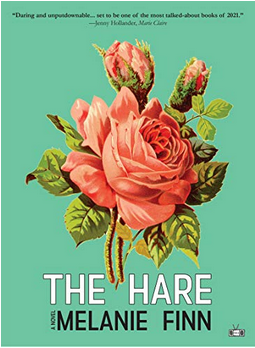Book Review: The Hare
Women who have a few years of life experience know Bennett Kinney as soon as we’re introduced to him: handsome, charming, topped up with stories of places he’s been and people he’s known—getting drunk with Truman Capote, sailing with James Taylor, hanging out in Cuba with Hunter S. Thompson—full to the brim of bullshit and himself.
His façade is so flimsy, so untenable—he of the hand-rolled cigarettes and correct wine but an old BMW missing a headlight—that to maintain the act requires him to target and seduce a painfully naïve, sheltered young woman half his age and wildly out of her depth. That young woman is Rosie Monroe, the narrator of Melanie Finn’s most recent novel, The Hare.

Rosie comes from downtrodden Lowell, Massachusetts, orphaned at age five when a car accident kills her parents and no one even attempts to explain this to her. She is simply delivered to her father’s mother, an embittered woman who believes that Fate comes for you if you dare to want too much. Rosie grows up “in the cold, steady drizzle of Gran’s resentment.”
Still, she dares to find joy in art, and secretly applies to art school where she wins a full scholarship at Parsons School of Design, whose gatekeepers mistake her earnestness for irony. With that, 18-year-old Rosie transports from Lowell to lower Manhattan and into the warm, enveloping clutches of Bennett. There is a narcotic ecstasy in finally—finally!–being chosen that allows her to ignore the questions about him, and herself, that nag at her.
For Bennett, Rosie is the perfect vessel: grateful, unquestioning, a tabula rasa onto which he can rewrite his own story, the Galatea to his Pygmalion. Perhaps surprisingly, Bennett really does come from old money, so he is intimate with—but cast out of—the world in which he schools her.
Friends of his mother allow him to live in the boathouse on their estate along Connecticut’s Gold Coast; no one else will have him. When Rosie admits to him that she’s pregnant, he is overjoyed. The little family bumps along until the night a frantic Bennett has Rosie shove some belongings in a bag, grab baby Miranda, and high-tail it from the estate in the Beemer as the police close in. With no explanation, Bennett delivers them all to a tiny cottage in the wilds of northern Vermont.
For Rosie, these sudden shifts from a before to an after are a hallmark of her existence. What she knows how to do better than anything—the thing that Bennett is absolutely incapable of doing—is to adapt.
Bennett is forever disappearing and then rematerializing, expecting to be welcomed in and cared for, while contributing nothing. In deeply rural Vermont, in a summer cottage with no heat, Bennett is incapable of grasping “what needed to be done to simply not die in winter . . . He didn’t know how to light the stove. He was still waiting for tea and scones and rose petal jam.”
Instead, it is their neighbor, Billy—Wilhemina—who teaches Rosie what she needs to know to survive, including how to cleanly kill and field dress a deer.
Finn lays the story out in chunks of years, an inspired structure that allows us to experience Rosie’s transformation from a socially awkward teenager who is forever trying to decode and navigate situations she has never encountered before, into a hardened, weary, self-sufficient woman whose only concern is to provide for herself and her daughter. Too late, Rosie realizes that she “had lacked vision. She had failed to see that she could have had the child without the man.”
The novel’s title comes from a painting that Bennett’s benefactor Hobie owns and shows to Rosie when they first meet. “Rosie regarded the van Eyck now, the pompous man, the precocious young woman . . . fastened into her life with all the windows shut, she had not yet realized her predicament. But the artist had: the dead hare in the maid’s hands.”
Arguably, Rosie never does truly realize her predicament, even after Bennett’s drug dealer offers to forgive his debt in exchange for photos of Miranda, even after Bennett is arrested and shipped off for a seven-year prison stint; she stays in the place he can come back to, and come back he does.
The author has constructed a compelling, emotionally resonant story with closely observed details that make the reader flinch in recognition. Finn’s prose is sublime, and pins us in place, waiting to learn what comes next. Like Rosie, like the hare, we are trapped by the story until the story finally lets us go.
Jennifer Bort Yacovissi
Jenny Yacovissi grew up in Bethesda, Maryland, just a bit farther up the hill from Washington, D.C. Her debut novel Up the Hill to Home is a fictionalized account of her mother’s family in Washington from the Civil War to the Great Depression. In addition to writing historical and contemporary literary fiction, Jenny reviews regularly for the Washington Independent Review of Books and the Historical Novel Society. She belongs to the National Book Critic’s Circle and PEN/America. She also owns a small project management and engineering consulting firm, and enjoys gardening and being on the water. Jenny lives with her husband Jim in Crownsville, Maryland. To learn more about the families in Up the Hill to Home and see photos and artifacts from their lives, visit http://www.jbyacovissi.com/about-the-book.
- Web |
- More Posts(33)